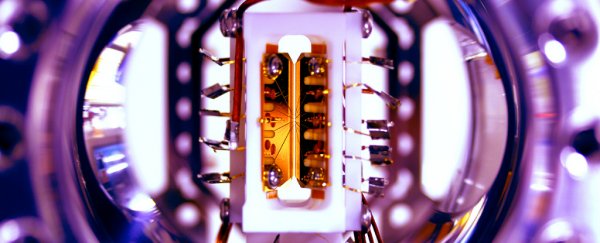Researchers have built the first quantum computer that can not only be programmed, but, just like a regular computer, can actually be reprogrammed, too.
This latest device is only made from five atoms, but it's a huge step towards building scalable, functioning quantum computers that could change the way we process data forever.
Quantum computers have the power to be exponentially more powerful than today's regular computers, which are based on units of information called bits that can either be in a '0' or '1' state.
Quantum processors, on the other hand, are made of qubits, which can be a '1', '0', or both at the same time - a state known as 'superposition'.
But while many groups have built small quantum computing devices in the past, most of these have only been hard-wired to solve a single problem, and any reprogramming requires complex physics.
This new device is different, because it's easily reprogrammable, and it's already been shown to solve three algorithms in a single step - something that would require several operations for a normal computer to calculate.
The team from the University of Maryland is calling the new device a "module", and it's made up of five ions - charged atoms - trapped in a line by a magnetic field.
These ions make up the qubits of the quantum computer, and the researchers could effectively put them in one of the three quantum states - 1, 0, or superposition.
At this point in the process, most researchers struggle to easily switch the state of those qubits, so they remain pretty fixed in the state they're originally in.
But the Maryland researchers combined their qubit set-up with some good old-fashioned software, which directs a laser beam to switch the state of the five different qubits.
By shining the laser on these trapped ions, the device could move them into a different quantum state, effectively reprogram their machine.
"By reducing an algorithm into a series of laser pulses that push on the appropriate ions, we can reconfigure the wiring between these qubits from the outside," said lead researcher Shantanu Debnath. "It becomes a software problem, and no other quantum computing architecture has this flexibility."

The best part is the fact this module can now be linked to other modules, either by physically moving the ions, or using photons to carry information between them, which means the system is totally scalable.
"By directly connecting any pair of qubits, we can reconfigure the system to implement any algorithm," said Debnath. "While it's just five qubits, we know how to apply the same technique to much larger collections."
The team reprogrammed the device to run three problems that quantum computers are known to be able to solve - the Deutsch-Jozsa algorithm (which it could complete with 95 percent success rate), the Bernstein-Vazirani algorithm (90 percent successful), and the Quantum Fourier Transform algorithm (70 percent).
Overall, the software used to program the module was 98 percent accurate - something that's impressive for a first attempt, but will need to be improved for future iterations.
The team is now working on adding more qubits to their module - they think they could add up to 100 - so they can eventually build a quantum computer that can be used as easily as a modern phone, without any complicated quantum reprogramming required.
"For any computer to be useful, the user should not be required to know what's inside," said team leader Christopher Monroe. "Very few people care what their iPhone is actually doing at the physical level. Our experiment brings high-quality quantum bits up to a higher level of functionality by allowing them to be programmed and reconfigured in software."
The research has been published in Nature.
